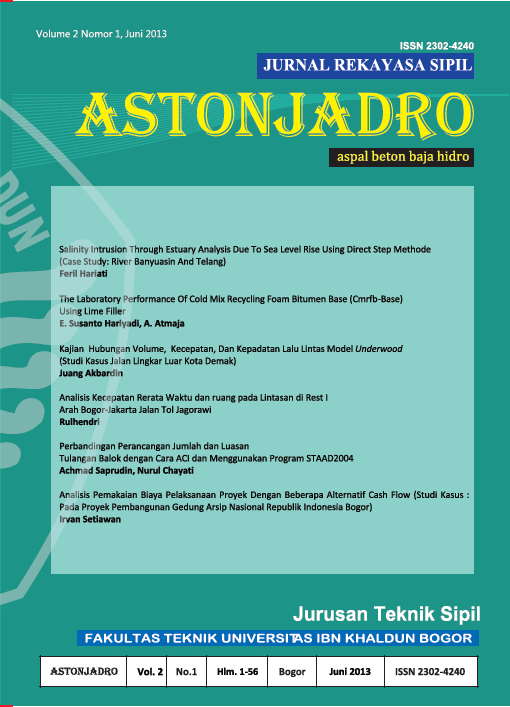THE LABORATORY PERFORMANCE OF COLD MIX RECYCLING FOAM BITUMEN BASE (CMRFB-BASE) USING LIME FILLER
DOI:
https://doi.org/10.32832/astonjadro.v2i1.775Keywords:
Recycled asphalt pavement, foamed Bitumen, hydrated limeAbstract
Due to the demand of road infrastructure increases in Indonesia, it needs an alternative technology having economically, effectively and efficiently results. Reused (recycling) the existing old pavement materials may be one solution. It's expected repairing and improving structural capacity of pavement. One of technology that can be used either for repairing or improving the quality of recycling materials is foam bitumen.
The objective of this research is to evaluate the characteristics and to know the strength value of cold mix recycling base by foam bitumen using lime filler. This research uses four types variance of foam bitumen, that is 2%, 2,5%, 3% and 3,5%, and two types of lime filler (1% and 1,5%). According laboratory result is got CMRFB-Base strength based on Indirect Tensile Strength (ITS). If the sample with filler 1%, the standard of optimum foam bitumen is 2,5% with ITS dry about 186,34 KPa, ITS soaked about 125,75 Kpa and TSR is 67,49%. Meanwhile, for the sample with the filler 1,5%, the standard of optimum foam bitumen is 2,5% with ITS dry about 207,71 KPa, ITS soaked about 168,17 Kpa and TSR is 80,96%.
For the lowest Static Modulus approximately at foam bitumen 3,5% with filler contain 1,5% = 627,54 MPa and filler contain 1% is around 633,08 Mpa. For the highest Static Modulus approximately at foam bitumen 2,5% with filler contain 1,5% is around 1.857,29 MPa and filler contain 1% is around 1.268,62 MPa.
References
Ali, S. 2002. Laboratory Performance of Lapis Tipis Aspal Beton (Lataston) using Lime Filler. Thesis. Magister Program of Highway Engineering and System. Bandung Institute of Technology.
ARRA. 2001. Basic Asphalt Recycling Manual. US Department of Transportation FHA.
Csanyi L.H. 1957. Foamed Asphalt in Bituminous Paving Mixtures. Highway Research Records No. 160, National Research Council, Washington, DC, pp. 108-122
Eller, A. Olson, R. 2009. Recycled Pavement Using Foamed Asphalt in Minnesota. Research Report. Minnesota Department of Transportation.
Putman, B.J. Aune, J. Amirkhanian, S.N. 2002. Recycled Ashalt Pavement (RAP) Used In Superpave Mixes Made With Rubberized Asphalt. Clemson University. South Carolina USA.
Romanoschi, S.A. Hossain, M. Heitzman, M. Gisi, A.J. 2003. Foamed Asphalt Stabilized Reclaimed Asphalt Pavement : A Promising Technology for Mid-Western Roads. Proceedings of the 2003 Mid-Continent Transportation Research Symposium, Ames, Iowa. Iowa State University.
Uzarowski, L. Manolis, S. Lu, P. Greco, M. 2008. Initial Evaluation of Foamed Asphalt Stabilization Using Modified Asphalt Cement. Proceeding of Soils and Material : Warm Asphalt as Sustainable Strategy for Pavement Conference. Ontario.
Wirtgen GmbH. 2004. Wirtgen Cold Recycling Mnual, 2nd Edition, Germany.
Yamin, A., Widayat, D. 2008. The Application of Foamed Bitumen for Recycled Asphalt Pavement. Road and Bridge Journal Volume 25 No.2. page. 130-153.
Downloads
Published
How to Cite
Issue
Section
License
Paper submitted to ASTONJADRO is the sole property of the Astonjadro Journal. Unless the author withdraws the paper because he does not want to be published in this journal. The publication rights are in the journal Astonjadro.ASTONJADRO
LICENSE
This work is licensed under a Creative Commons Attribution-ShareAlike 4.0 International License.
Based on a work at http://ejournal.uika-bogor.ac.id/index.php/ASTONJADRO













